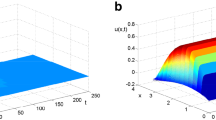Abstract
The Belousov–Zhabotinskii reaction is considered in one and two-dimensional reaction–diffusion cells. Feedback control is examined where the feedback mechanism involves varying the concentrations in the boundary reservoir, in response to the concentrations in the centre of the cell. Semi-analytical solutions are developed, via the Galerkin method, which assumes a spatial structure for the solution, and is used to approximate the governing delay partial differential equations by a system of delay ordinary differential equations. The form of feedback control considered, whilst physically realistic, is non-smooth as it has discontinuous derivatives. A stability analysis of the sets of smooth delay ordinary differential equations, which make up the full non-smooth system, allows a band of Hopf bifurcation parameter space to be obtained. It is found that Hopf bifurcations for the full non-smooth system fall within this band of parameter space. In the case of feedback with no delay a precise semi-analytical estimate for the stability of the full non-smooth system can be obtained, which corresponds well with numerical estimates. Examples of limit cycles and the transient evolution of solutions are also considered in detail.
















Similar content being viewed by others
References
J.M.L. Corbel, J.N.J. Van Lingen, J.F. Zevenbergen, O.L.J. Gijzeman, A. Meijerink, Strobes: pyrotechnic compositions that show a curious oscillatory combustion. Angew. Chem. Int. Ed. 52, 290–303 (2013)
B.P. Belousov, An oscillating reaction and its mechanism. Sborn. referat. radiat. med. (Medgiz, Moscow, 1959), p. 145
F. Sagues, I.R. Epstein, Nonlinear chemical dynamics. Dalton. Trans. 7, 1201–1217 (2003)
R.J. Field, E. Körös, R. Noyes, Oscillations in chemical systems. II. thorough analysis of temporal oscillation in the Bromate–Cerium–Malonic Acid system. J. Am. Chem. Soc. 94, 8649–8664 (1972)
R.J. Field, R.M. Noyes, Oscillations in chemical systems. IV. limit cycle behavior in a model of a real chemical reaction. J. Chem. Phys. 60, 1877–1884 (1974)
J.J. Tyson, The Belousov–Zhabotinskii Reaction (Springer, New York, 1976)
J.J. Tyson, Oscillations, Bistability and echo waves in models of the Belousov–Zhabotinskii reaction. Ann. NY. Acad. Sci. 316, 279–295 (1979)
T.R. Marchant, Cubic autocatalytic reaction–diffusion equations: semi-analytical solutions. Proc. R. Soc. Lond. A458, 873–888 (2002)
T.R. Marchant, Cubic autocatalysis with Michaelis–Menten kinetics: semi-analytical solutions for the reaction–diffusion cell. Chem. Eng. Sci. 59, 3433–3440 (2004)
L. Forbes, Stationary patterns of chemical concentration in the Belousov–Zhabotinskii reaction. Phys. D 43, 140–152 (1990)
L. Forbes, On stability and uniqueness of stationary one-dimensional patterns in the Belousov–Zhabotinsky reaction. Phys. D 50, 42–58 (1991)
Z. Noszticzius, W. Horstemke, W.D. McCromick, H.L. Swinney, W. Tam, Sustained chemical waves in an annular gel reactor: a chemical pinwheel. Nature 329, 619–620 (1987)
W. Tam, W. Horstemke, Z. Noszticzius, H.L. Swinney, Sustained sprial waves in a continuously fed unstrirred chemical reactor. J. Chem. Phys. 88, 3395–3396 (1988)
S. Bagyan, T. Mair, E. Dulos, J. Boissonade, P. DeKepper, S. Muller, Glycolytic oscillations and waves in an open spatial reactor: impact of feedback regulation of phosphofructokinase. Biophys. Chem. 116, 67–76 (2005)
A. Lavrova, S. Bagyan, T. Mair, M. Hauser, L. Schimansky-Geier, Modeling of glycolytic wave propagation in an open spatial reactor with inhomogeneous substrate flux. Biosystems 97, 127–133 (2005)
K. Sriram, Effects of positive electrical feedback in the oscillating Belousov–Zhabotinsky reaction: experiments and simulations. Chaos Soliton Fract. 28, 1055–1066 (2006)
R. Zhu, L. Qian, Eliminating chaos in the Belousov–Zhabotinsky reaction by no-delay feedback and delayed feedback. Theor. Chem. Acc. 110, 85–91 (2003)
L. Györgyi, R.J. Field, A three-variable model of deterministic chaos in the Belousov–Zhabotinsky reaction. Nature 335, 808–810 (1992)
G. Lipták, G. Szederkényi, K.M. Hangos, Hamiltonian feedback design for mass action law chemical reaction networks. IFAC Pap. Online 48–13, 158–163 (2015)
V. Vanag, I.R. Epstein, Design and control of patterns in reaction–diffusion systems. Chaos 18, 026107 (2008)
M. di Bernardo, C. Budd, A.R. Champneys, P. Kowalczyk, Piecewise-Smooth Dynamical Systems: Theory and Applications (Springer, London, 2008)
M.K. Camlibel, W. Heemels, J.M. Schumacher, Stability and controllability of planar linear bimodal complementarity systems, in Proceedings of the 42nd IEEE Conference on decision and control, Hawai, USA 1651–1656 (2003)
R. Csikja, B.M. Garay, J. Tóth, Chaos via two-valued interval maps in a piecewise affine model example for hysteresis, in Proceedings of the 19th International Symposium on Mathematical Theory of Networks and Systems, Hungary 187–194 (2010)
H. Takada, Y. Shimizu, M. Miyao, The number of autocatalytic reactions in systems of oscillating reactions. Forma 18, 67–82 (2003)
V. Vanag, A. Zhabotinsky, I. Epstein, Pattern formation in the Belousov–Zhabotinsky reaction with photochemical global feedback. J. Phys. Chem. A 104, 11566–11577 (2000)
W. Jahne, A.T. Winfree, A survey of spiral wave behaviours in the Oregonator model. Int. J. Bifurc. Chaos 1, 445 (1991)
D.L. Ropp, J.N. Shadid, Stability of operator splitting methods for systems with indefinite operators: reaction–diffusion systems. J. Comput. Phys. 203, 449–466 (2005)
H.Y. Alfifi, T.R. Marchant, M.I. Nelson, Generalised diffusive delay logistic equations: semi-analytical solutions. Dynam. Cont. Dis. Ser. B 19, 579–596 (2012)
H.Y. Alfifi, T.R. Marchant, M.I. Nelson, Semi-analytical solutions for the 1- and 2-D diffusive Nicholson’s blowflies equation. IMA J. Appl. Math. 79, 175–199 (2014)
T. Erneux, Applied Delay Differential Equations (Springer, New York, 2009)
J. Hale, Theory of Functional Differential Equations (Springer Verlag, New York, 1977)
Acknowledgments
The authors would like to thank an anonymous referee for their useful comments.
Author information
Authors and Affiliations
Corresponding author
Appendix: Expressions for the semi-analytical ODEs
Appendix: Expressions for the semi-analytical ODEs
This appendix presents relevant expression for for the semi-analytical models. The \(M_i\) for the 1-D model (6) are
The \(N_i\) for the 2-D model (8) are
The delay terms are defined as
Rights and permissions
About this article
Cite this article
Alfifi, H.Y., Marchant, T.R. & Nelson, M.I. Non-smooth feedback control for Belousov–Zhabotinskii reaction–diffusion equations: semi-analytical solutions. J Math Chem 54, 1632–1657 (2016). https://doi.org/10.1007/s10910-016-0641-8
Received:
Accepted:
Published:
Issue Date:
DOI: https://doi.org/10.1007/s10910-016-0641-8
Keywords
- Mathematical modelling
- Reaction–diffusion-delay equations
- Belousov–Zhabotinskii
- Hopf bifurcations
- Non-smooth feedback control




